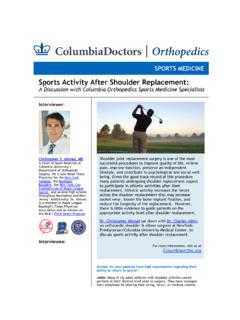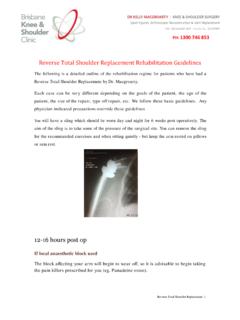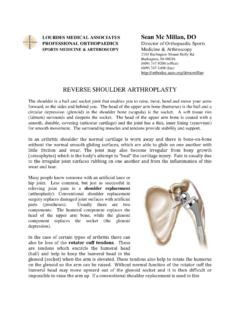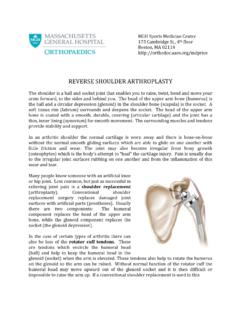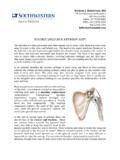Transcription of Reverse Total Shoulder Replacement Oct 2009
1 HOLLAND ORTHOPAEDIC & ARTHRITIC CENTRE 43 Wellesley Street East Toronto, ON Rehabilitation Program Following Reverse Total Shoulder Replacement Richard Holtby Assistant professor, Department of Surgery University of Toronto Copyright 2009 Sunnybrook Health Sciences Centre All rights reserved by Sunnybrook Health Sciences Centre, operating as the Holland Orthopaedic & Arthritic Centre. No part of this publication may be reproduced or transmitted by any means, including photocopying and recording, or stored in a retrieval system of any nature without the written permission of the Holland Orthopaedic & Arthritic Centre.
2 (416) 967-8626 Rehabilitation Program Following Reverse Total Shoulder Replacement 2 ACTIVITIES OF DAILY LIVING FOLLOWING YOUR Total Shoulder SURGERY The Reverse , or inverse Total Shoulder arthroplasty is usually used for patients with arthritis who have an associated irreparable rotator cuff tear, complex fractures, or for the revision of a previously failed conventional arthroplasty in which the rotator cuff tendons are deficient/absent. Before Your Surgery You can prepare your home so that things are easier to do after your surgery: Practice doing things using only the arm that will not be operated ( preparing meals, washing yourself, wiping yourself after using the toilet with one hand).
3 Make sure you have a few extra pillows. You will need these to support your Shoulder when sleeping on your back or unoperated side. Prepare and freeze meals in advance, purchase easy to prepare meals or frozen dinners that are easy to open. Ask your friends and family for assistance with cleaning and meal preparation. A reusable hot/cold pack is helpful for any swelling or tense muscles that you may experience after surgery. A reacher can help picking things up from the floor and getting hard to reach items. Reachers are available at the hospital gift shop or medical supply stores. An electric can opener and an electric toothbrush may be helpful (especially if you are having surgery on your dominant arm).
4 Move your nightstand close to your unoperated side. Make sure you can easily reach the lamp and are able to turn it on with your unoperated arm. After Your Surgery Sleeping You should sleep on your back or unoperated side. When sleeping on your back, support your operated Shoulder by placing a pillow underneath. When sleeping on your side, a pillow can be placed across your chest to support your operated arm. You may be more comfortable sleeping in a sitting position. Your surgeon will likely request that you sleep with you sling on. Bathing A non-slip mat in your shower/bath tub will improve safety.
5 Your arm can hang gently at your side while bathing. Don t forget to wash underneath your operated arm. You can increase your independ-ence with bathing by using a long-handled sponge to wash your back and legs using your unoperated arm. You may cover your bandage with plastic while showering. Your nurse will speak to you re-garding care of your incision and bandage. Dressing Loose fitting clothing and button-up shirts are ideal. You may do up/undo buttons using your operated arm. Dress your operated arm first, then your unoperated side. When undressing, begin with your unoperated arm, then your operated arm.
6 Bras should be fastened in front, turned to the back using your unoperated arm and then the straps pulled up last. Your sling should be worn over your clothes. If you wear shoes with laces, you may want to consider elastic shoelaces or slip-on shoes - it is difficult to tie laces with one hand. **If you have any questions or concerns about this information please speak to your Occupational Therapist or Nurse. ** Rehabilitation Program Following Reverse Total Shoulder Replacement 3 Regular Sling The regular sling is designed to keep your operated Shoulder in a comfortable position after your surgery.
7 The sling is worn for comfort for approximately 3-4 weeks. This sling should be removed for bathing, dressing and exercising. You can let your arm hang freely at your side. After 3-4 weeks, you may discard the sling and start to use your arm for light activities. Lifting objects heavier than a plate of food should not be done until 12 weeks following your surgeon unless otherwise indicated by your surgeon. There is a charge to cover the cost of the sling. The bill will be given to you for payment at the Business Office when you are discharged from the hospital. You will notice that a blue pad comes with your sling.
8 If it is not on the white strap, insert the strap through the openings of the pad. When the sling is on, this pad helps to decrease the stress from the strap on top of your non-operated Shoulder . Place the forearm of your operated arm into blue envelope pocket. This pocket is the right length if the bottom of your little finger is covered by the material. Make sure your elbow rests at the back of the blue envelope pocket where the material curves. The elbow should rest at a 90 degree angle (L shape) in the blue pocket. Using your non-operated arm bring the strap behind your neck so the Shoulder pad rests on your non-operated Shoulder .
9 Put the strap through the two silver rings near your wrist. Pull the strap back up towards your chest and attach Velcro. The big white loop is an optional rest for your thumb. If needed, you may need to remove the sling to adjust the length of the strap by sliding the buckle, which is located at the back of the strap, where the strap meets the blue envelope pocket. The following exercise program has been designed to provide guidelines and basic instructions for you and your physical therapist to help restore your Shoulder s range of motion and strengthen your muscles. Should you have any questions about your surgery, you can contact your surgeon.
10 Any questions about your exercise program can be directed to the Rehabilitation Department at (416) 967-8626. How to put on and remove the arm sling Rehabilitation Program Following Reverse Total Shoulder Replacement 4 4. Squeeze a soft ball. Elbow, Wrist and Hand Mobility After your Shoulder surgery, it is important to maintain full mobility of the joints below the affected Shoulder . These exercises should be done 4-5 times throughout the day with the sling/brace removed and your elbow tucked in at your side. Elbow: In sitting or lying, gently bend and straighten your elbow. Assist with other hand, if needed.








